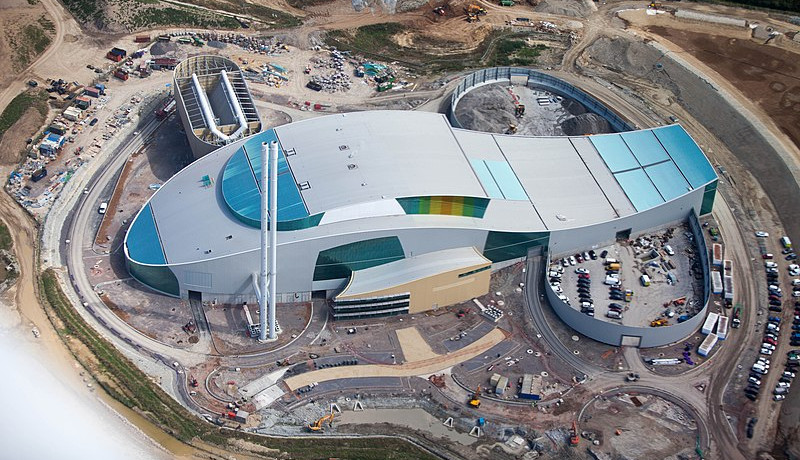Pictured above is a new 24 MW ‘waste to energy’ (WTE) plant in the UK.
There are many countries around the world that use waste-to-energy technologies to generate electricity. These technologies involve burning municipal solid waste (MSW) to produce steam, which is then used to generate electricity through a turbine.
WTE facilities can be an effective way to reduce and even eliminate the amount of waste sent to landfills, while also generating electricity.
Some countries, such as Sweden and Denmark, have been particularly successful in implementing WTE technologies, with a significant portion of their electricity being generated from waste. Other countries that use WTE technologies include Japan, the United States, Germany, and China, among others.
While WTE technologies can be an effective way to manage waste and generate renewable energy, they are not without their challenges. Some critics have raised concerns about air pollution and emissions associated with these facilities, as well as the potential for waste incineration to discourage recycling and other waste reduction efforts.
Do WTE facilities produce harmful emissions?
Waste-to-energy (WTE) facilities can produce harmful emissions if they are not properly designed and operated. When municipal solid waste (MSW) is burned to generate energy, it produces various types of emissions, and air pollutants.
However, modern WTE facilities are designed to minimize this through advanced pollution control technologies and other best practices. For example, these facilities often use scrubbers and filters to remove pollutants from the flue gas before it is released into the atmosphere.
While WTE facilities do produce emissions, they are generally considered to be less harmful than the emissions associated with landfilling, which can include the release of large quantities of methane.
Denmark’s electricity from WTE production
According to the Danish Waste-to-Energy Association, waste-to-energy (WTE) plants in Denmark provide approximately 4% of the country’s electricity consumption. However, this figure varies from year to year depending on a number of factors such as the amount of waste available for incineration and the efficiency of the WTE plants.
It’s also worth noting that in addition to producing electricity, WTE plants in Denmark also provide district heating, which is used to heat homes and buildings throughout the country. In fact, the Danish government has set a goal to transition the country to 100% renewable energy by 2050, and district heating from WTE plants is expected to play an important role in achieving this goal.
Sweden’s electricity from WTE production
Sweden is a world leader in waste-to-energy (WTE) production and has one of the highest rates of WTE utilization in the world. According to the Swedish Energy Agency, waste-to-energy plants provide about 7% of Sweden’s total electricity consumption and about 20% of its district heating needs.
Sweden has a long-standing commitment to sustainable waste management, and the country has invested heavily in WTE technology over the past several decades. WTE plants in Sweden are highly efficient and are designed to extract as much energy as possible from the waste that is processed, while minimizing environmental impacts such as emissions and ash production.
In addition to producing electricity and district heating, WTE plants in Sweden also generate steam that is used for industrial processes and other applications.
Japan’s electricity from WTE production
Japan is also one of the world’s leading countries in terms of waste-to-energy (WTE) production. According to the Japan Waste Management Association, there are currently more than 200 waste-to-energy plants operating in Japan, which collectively produce around 1.5% of the country’s total electricity supply.
Japan’s approach to waste management is heavily focused on reducing waste generation and increasing recycling rates, but WTE is seen as an important part of the country’s waste management strategy, particularly for non-recyclable waste. Japan’s WTE plants use a variety of technologies, including incineration, gasification, and pyrolysis, to generate energy from waste.
In addition to producing electricity, some WTE plants in Japan also generate steam for industrial processes.
Small scale WTE plants
It is possible to build small-scale waste-to-energy (WTE) plants that serve a single town or community. These types of plants, also known as “community-scale” WTE facilities, can be designed to process a smaller volume of waste than larger municipal-scale plants.
Community-scale WTE plants can offer several benefits over larger plants. For example, they can be more cost-effective and easier to permit and construct, and they can provide a more localized solution for waste management and energy production. In addition, community-scale plants can often be designed to integrate with existing infrastructure, such as district heating systems or local industrial facilities.
Combined with schemes like Hydro electricity generation, waste-to-energy (WTE) is an obvious solution for small towns and communities as well as large cities. Disposing of waste and creating energy at the same time is a win, win situation.
